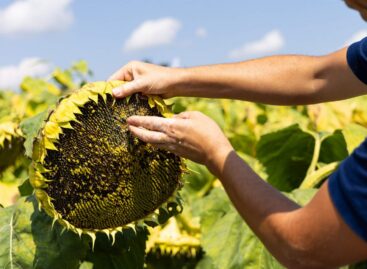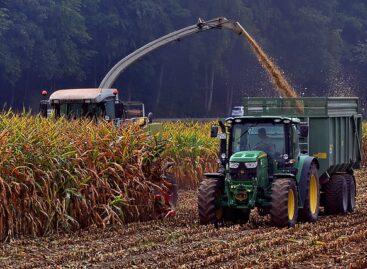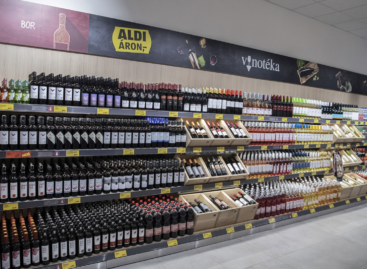Stable above 700 thousand hectares: domestic sunflower cultivation continues to strengthen
Hungary is a leader in sunflower cultivation: over 700,000 hectares of the third most important arable crop have been cultivated in the past two years. This year’s harvest of 1.7 million tonnes means that Hungarian farmers have achieved an average of 2.38 tonnes per hectare. According to Syngenta, the market leader in sunflower seeds, there are further reserves hidden in the plant: farmers participating in the company’s partner program regularly achieve yields of 5 tons and more per hectare, and under experimental conditions, they have already harvested 8 tons.

The sunflower segment has achieved the greatest progress in recent years: the important arable crop was already grown on more than 730 thousand hectares in 2025, while corn production is at an unprecedented low due to its exposure to weather.
According to experts from Syngenta, the market leader in sunflower seeds, Hungary is now one of the highest-producing markets in Europe, where a national average of 3.01 tons per hectare was also measured, which is already a record. In this year’s difficult season, domestic farmers harvested an average of 2.4 tons per hectare. The sector also contributes to domestic honey production, as most of the Hungarian honey is provided by oilseed crops.
This season started off difficult
In the 2025 season, the cooling after spring sowing resulted in heterogeneous emergence and made weed control difficult. Although phytotoxic symptoms appeared in several places, the sunflower recovered from these without significant damage. Downy mildew infection was stronger this year in the cooler and rainier areas. White mold stem infection was also experienced in several places, and among the insects, aphids and locusts caused the most problems. This year, too, it was a big problem that there was hardly any precipitation in some areas of the country during critical development stages.
New directions in breeding, technology
Syngenta is continuously developing its hybrids, which are better adapted to the challenges arising from changing plant diseases and climate change. The company’s latest A.I.R. weed control technology is the most flexible system on the market today. In addition, high-oleic acid hybrids are gaining an increasing role in the offer, with about 40 percent of the seeds sown already coming from this segment.
Today, sunflower can mean serious profitability for farmers with conscious hybrid selection and technology. Due to the narrowing of crop rotations and climate change, sunflower has taken over the role of winter rapeseed in many areas, and also offers a stable alternative to corn.
Growers are increasingly conscious of their sunflowers: they are placing great emphasis on optimal nitrogen supply, investigating the benefits of narrow row spacing technologies, and there is a growing demand for biological products to help with stress management, as well as fungicide solutions in plant protection. Where possible, they support the development of sunflowers with irrigation: even 20-30 millimeters of water – which is hardly a noticeable advantage in corn – is already of considerable importance in terms of yield in sunflowers.
The 6-ton program: a new approach to sunflower cultivation
Syngenta’s innovative 6-ton program focuses on discovering ideal agronomic elements. For years, the company’s experts have been working with growing partners to investigate the key factors that contribute to exploiting the potential of genetics. The program focuses on nitrogen supply, water conservation, stress management, and expert support for various experiments. Experts worked closely with 50 farmers in the Sunflower Workshop in the program, and 25 additional producers joined the crop competition.
The winner of the competition this year in Cigánd, Borsod-Abaúj-Zemplén County, achieved a yield of 5.45 t/ha with the Sureli hybrid. The first place winner in the irrigated areas competing in a separate category achieved a yield of 6.09 t/ha with the Suliano, a high-oleic Syngenta hybrid.
There is more to it than that
The outstanding yield potential of Syngenta sunflower hybrids is demonstrated by the fact that the SY Barilio hybrid yielded 8 t/ha in the KITE small-plot experiment. According to the company, this also proves that there is still plenty of potential in sunflower cultivation. Based on their forecast, the crop’s sown area is expected to stabilize at a similar level and remain among the main arable crops in the next decade. Increasing the average yield would represent a significant success for the entire Hungarian agriculture.
Related news
Sunflower and rapeseed seed prices have decreased
🎧 Hallgasd a cikket: Lejátszás Szünet Folytatás Leállítás Nyelv: Auto…
Read more >Drought, poor harvest, technological breakthroughs – this is how the 2025 agricultural season ended
🎧 Hallgasd a cikket: Lejátszás Szünet Folytatás Leállítás Nyelv: Auto…
Read more >Autumn harvest nears end in Békés County
🎧 Hallgasd a cikket: Lejátszás Szünet Folytatás Leállítás Nyelv: Auto…
Read more >Related news
Bread and wine for 399 forints, mulled wine for 450 forints: ALDI opens its own downtown Christmas market
🎧 Hallgasd a cikket: Lejátszás Szünet Folytatás Leállítás Nyelv: Auto…
Read more >MBH Analysis Center: Hungarian tourism is soaring – further growth is expected in the hotel market
🎧 Hallgasd a cikket: Lejátszás Szünet Folytatás Leállítás Nyelv: Auto…
Read more >It’s really worth coming together: Lidl and its customers make Christmas more beautiful for 2,000 disadvantaged children
🎧 Hallgasd a cikket: Lejátszás Szünet Folytatás Leállítás Nyelv: Auto…
Read more >






